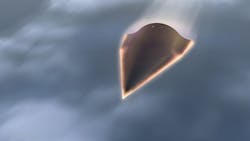Navy asks industry to develop enabling technologies for hypersonic weapons for carrier-based F/A-18E/F jet
ARLINGTON, Va. – U.S. Navy aviation experts are asking industry to develop a prototype hypersonic missile to enable the carrier-based F/A-18E/F Super Hornet jet fighter bomber to attack high-priority targets while giving the enemy little time to deploy countermeasures.
Officials of the Office of Naval Research (ONR) in Arlington, Va., issued a special notice (N00014-21-S-SN06) on Tuesday for the Screaming Arrow project to arm the Navy Super Hornet with hypersonic weapons.
This project seeks to develop about three prototype Super Hornet-compatible hypersonic weapons for demonstration from F/A-18E/F combat aircraft that are operating aboard aircraft carriers. The prototype should consist of a cruiser, inter stage, and booster.
Demonstration will involve captive carriage, air launch separation, controlled flight, booster ignition, booster operation, separation the cruiser from the booster, cruiser-controlled flight, cruiser engine start, cruiser acceleration to cruise condition, cruiser at cruise condition, cruiser turndown, cruiser terminal phase flight trajectory, and cruiser flight impact of the hypersonic prototype.
The idea is to capitalize on previous and current hypersonic air-vehicle and propulsion developments to develop and field near-term hypersonic weapons for air-to-surface attack enemy surface warships and capital ships.
To make the hypersonic weapon compatible for deployment from aircraft carriers, the weapon must be no more than 15 feet long, 3.3 feet wide, and 3.75 feet high.
After initial design, the Screaming Arrow project will have three phases. The 7-month first phase will design a critical design of the all-up round. The 15-month second phase will fabricate components and subcomponents, and the 13-month third option will integrate the prototype with a Super Hornet aircraft for testing.
Companies interested should submit full proposals no later than 8 April 2021 to FedConnect at www.fedconnect.net. The Navy will make three separate contract awards, which should be awarded by September.
Email questions or concerns to the Navy's Kenneth Heeke at [email protected], or Jerome Kong at [email protected]. Email business questions to James Farnsworth at [email protected].
More information is online at https://beta.sam.gov/opp/3425631c508e439382f1a9dbafda110c/view.

John Keller | Editor-in-Chief
John Keller is the Editor-in-Chief, Military & Aerospace Electronics Magazine--provides extensive coverage and analysis of enabling electronics and optoelectronic technologies in military, space and commercial aviation applications. John has been a member of the Military & Aerospace Electronics staff since 1989 and chief editor since 1995.

